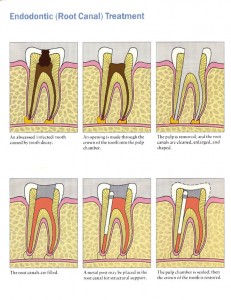What is root canal therapy?
Root canal therapy is a series of treatment done to the pulp to remove the source of infection in the pulp and prevent further infection to the disinfected pulp, thus maintaining its health and vitality.
Root canal treatment, on the other hand, is carried out if the pulp is seriously infected, and when tests reveal that the pulp is irreversibly damaged or dead. Root canal treatment involves removal of the damaged or dead pulp content and sealing the root canal space with a suitable material eg. gutta percha.
Treatment outcomes
Tooth which is identified for root canal treatment is usually grossly decayed or fractured. Patients who attend dental treatment show symptoms such as pain and sensitivity. After treatment, patients feel better in most cases, but failure of treatment may cause worsening of the symptoms.
Treatment outcomes of root canal treatment:
1. Successful healing characterised by:
a) improvement of symptoms
b) restoration of tooth function
c) no abnormal signs such as tenderness to palpation, swelling, mobility or sinus discharge
d) no radiographic evidence of abnormality
2. Failure of treatment
a) no improvement or worsening of symptoms
b) tooth not in function
c) tooth pain
d) tenderness or swelling of gums around the tooth
e) tooth mobility
f) presence of swelling and sinus tract formation
g) re-infection
What is the cause of root canal treatment failure?
1. Multiple root canals
Sometimes a tooth may have multiple root canals. A root canal may be missed and not cleaned and sealed. Also, the canal may not be cleaned and sealed to its full length. This happens if the length of the root canal is not measured correctly. As a result, bacteria harboring the uncleaned root canal will proliferate and cause infection of the entire root canal system.
2. Root perforation
An endodontic file is used to clean the root canal before sealing it with a suitable material. It looks like a needle and is engaged into the root canal. The file, if it misses the root canal, will perforate the side of the tooth, creating an opening. If the opening is not sealed, bacteria will enter through it and cause secondary infection of the tooth.
3. Filing beyond the root length
If the endodontic file reaches beyond the root length, the bacteria within the root canal will be transported to the periapical area (area surrounding the root) causing infection of the periapical area. In this case, a periapical surgery is needed to eliminate the infection.
4. Crack in the root of the tooth
A small crack at the root of the tooth may remain undetected till the completion of root canal treatment. The crack will allow bacteria to enter the root canal causing infection.
5. Microleakage
After root canal treatment, a suitable restorative material is used to fill the access cavity in the tooth. If the tooth is not properly restored or the material is unsuitable, marginal leakage may occur( marginal gap is the gap between the restorative  material and the tooth) causing ingress of bacteria and fluid into the root.
6. Root fracture
The root is so brittle after the pulp dies that it can fracture during root canal treatment. Assessment of the tooth prior to treatment is important to prevent such complication. In this case extraction of the tooth is advised. Endodontic surgery can be done to remove the fractured root but it has poor prognosis.
How to deal with root canal treatment failure?
1. Re-treatment
If the tooth has a crown on it, the crown has to be removed first. Then the material used to seal the root canal is removed. The cleaning and shaping process is done again, and the canal once again sealed and restored.
2. Extraction
Extraction is performed on the treated tooth if the tooth is badly infected, fractured or the prognosis for root canal treatment is poor.
3. Endodontic surgery
Infection reaching the periapical area can cause swelling and inflammation or even development of cyst or abscess. As a result,patient feels tenderness of the gums surrounding the area of the tooth. Apical surgery is done to get rid of the infection and promote healing of the periapical area.
you tube-Root Canal Treatment

nice article!!!
Got good information about RCT(Root Canal Treatment)..
Swap